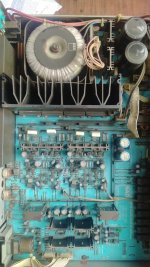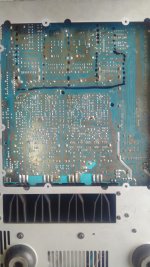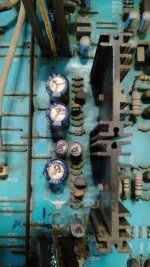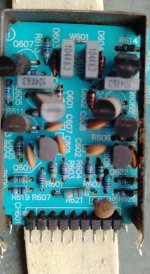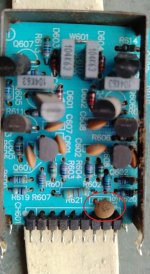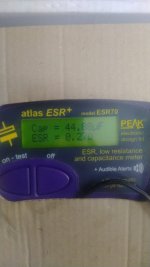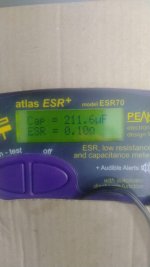I have a NAD C352 (2004) amplifier which has recently started making very loud crackling noise from L ch . It first started with soft crackling noise , lasting only for the first few min, after power ON and later the noise faded away with music playing properly on both ch. Now no music thru L ch. , only loud crackling noise, while the R ch is playing properly. Maybe the music is drowned behind the noise
During the initial troubleshooting , I found that the crackling noise is coming only from the L ch. (of both pre-amp out 1 & 2) regardless of volume control position, Offset- bouncy reading on L ch due to noise and under 2mV for R ch.
But if I remove the pre-power link from the rear side and directly connect thru power amp in, the output is proper without any crackling noise, no issues with offset.
Currently, for testing purpose , I'm using a pair of small 3" speakers, with series 47R (to reduce power)
All these years, no recapping was done, as recommended on many online forums and YT, largely due to cheap caps being used by NAD (perhaps, maybe they survived all these years due to active cooling fans). Slight browning underneath the PCB observed due to excessive heat dissipation (inadequate heat sink and undersized power resistors provided by NAD).
I have very basic troubleshooting skills and basic tools (cheap DMM & soldering kit) to carry out any further tests. If required , I have a friend , who has a DSO , ESR tester, variac, Fluke DMM, various capacitors and resistors for testing purpose in his LED lights mfg. company. The only problem is that I will have to carry the amp over there and work on it during office hours only.
I would be grateful to you all , with helping me solve this issue.
Repairs/Mods carried out in distant past by me (unrelated to the current problem)-
1. Installed 4 cooling fans, powered by ext wall wart, after the warranty period was over
2. Removed bad 20K balance control and replaced it with 10K+10K x 2 resistors (0.25W) (2009)
3. Reflowed transistors in preamp section due to audio cutting out intermittently (2009)
4. Removed tone defeat switch as its contacts went bad and shorted it with a link , such that the tone defeat was always OFF with tone controls working (2011)
5. Replaced the TL082 pair with OPA2134 and soldered missing 0.1 uF film bypass .
The other unconnected section of opamp was properly terminated thru 15K SMD input to gnd and output to gnd , output to input feedback (as the original TL082's unused section was left floating).(2012)
6. Basic dust cleaning/servicing carried out every year.
During the initial troubleshooting , I found that the crackling noise is coming only from the L ch. (of both pre-amp out 1 & 2) regardless of volume control position, Offset- bouncy reading on L ch due to noise and under 2mV for R ch.
But if I remove the pre-power link from the rear side and directly connect thru power amp in, the output is proper without any crackling noise, no issues with offset.
Currently, for testing purpose , I'm using a pair of small 3" speakers, with series 47R (to reduce power)
All these years, no recapping was done, as recommended on many online forums and YT, largely due to cheap caps being used by NAD (perhaps, maybe they survived all these years due to active cooling fans). Slight browning underneath the PCB observed due to excessive heat dissipation (inadequate heat sink and undersized power resistors provided by NAD).
I have very basic troubleshooting skills and basic tools (cheap DMM & soldering kit) to carry out any further tests. If required , I have a friend , who has a DSO , ESR tester, variac, Fluke DMM, various capacitors and resistors for testing purpose in his LED lights mfg. company. The only problem is that I will have to carry the amp over there and work on it during office hours only.
I would be grateful to you all , with helping me solve this issue.
Repairs/Mods carried out in distant past by me (unrelated to the current problem)-
1. Installed 4 cooling fans, powered by ext wall wart, after the warranty period was over
2. Removed bad 20K balance control and replaced it with 10K+10K x 2 resistors (0.25W) (2009)
3. Reflowed transistors in preamp section due to audio cutting out intermittently (2009)
4. Removed tone defeat switch as its contacts went bad and shorted it with a link , such that the tone defeat was always OFF with tone controls working (2011)
5. Replaced the TL082 pair with OPA2134 and soldered missing 0.1 uF film bypass .
The other unconnected section of opamp was properly terminated thru 15K SMD input to gnd and output to gnd , output to input feedback (as the original TL082's unused section was left floating).(2012)
6. Basic dust cleaning/servicing carried out every year.
Last edited:
But if I remove the pre-power link from the rear side and directly connect thru power amp in, the output is proper without any crackling noise, no issues with offset.
Thanks, my mistake.
Seeing as its a NAD it might be worth removing/linking out the muting FET's on the pre outputs as a test.
it might be worth removing/linking out the muting FET's on the pre outputs as a test.
You can also try swapping the 'amp modules' between channels if they are pluggable. They look to be discrete so might have dries on them.
Seeing as its a NAD
You can also try swapping the 'amp modules' between channels if they are pluggable. They look to be discrete so might have dries on them.
They are fully stereo independent Preamp (or discrete opamp?) module 1 & 2 module. Preamp module 2 is connected to Power amp by those links. The volume knob controls both preamp modules 1 & 2 simultaneously. So, the problem must be before those 2 preamp modules, as the L ch. noise is present on both preamps output. I tried reflowing almost all of the preamp section barring those components vertical modules . No luck, still noisy.You can also try swapping the 'amp modules' between channels
Next step , I will try to remove electrolytic capacitors in the preamp section and check them
Attachments
Looking at the diagram and the output of the preamp stage feeds the power amp directly. A problem in that area would nit be affected by the volume control. A scope would make this easier but without and I would be tempted to change the transistors and FET.
The volume control wiper feeds in on pin 4 for the left channel and the output is on pin 2. I can't see it being fussy on the three bjt transistors.

The volume control wiper feeds in on pin 4 for the left channel and the output is on pin 2. I can't see it being fussy on the three bjt transistors.
Can I use audio signal tracer (made up of 0.1uF capacitor & some series R , giving input to a Class AB based PC speaker) safely in this area ?A scope would make this easier
Just check the signal path at various points starting from the input and find out where signal disappears.No 1KHz sinewave seen on the left ch Pre out RCA.
Today I swapped the preamp modules and reflowed solder on the faulty preamp module. Now the current situation is-
1 Audio coming at proper volume from L ch (previously -no sound on L ch, only crackling noise at full blast irrespective of vol. pot position but R ch was ok)
2 Crackling noise is now dependent on vol. knob position , varying from nil to full crackling blast directly promotional to changes in knob position
3 Probed various points with audio signal tracer circuit (separate mono Class AB + speaker), R ch of both the preamp module ok, L ch. of both the preamp module noisy. The preamp module connected by vol. pot. is putting out noise depending upon vol. knob position
4 Same situation as point 3, both pre out 1 & 2 RCA socket noisy depending upon vol. knob position
5 Removed few capacitors (220uF and 47uF) around the heatsink area, will check its ESR and do the preamp module transistors checking tomorrow (as suggested by Mooly )
1 Audio coming at proper volume from L ch (previously -no sound on L ch, only crackling noise at full blast irrespective of vol. pot position but R ch was ok)
2 Crackling noise is now dependent on vol. knob position , varying from nil to full crackling blast directly promotional to changes in knob position
3 Probed various points with audio signal tracer circuit (separate mono Class AB + speaker), R ch of both the preamp module ok, L ch. of both the preamp module noisy. The preamp module connected by vol. pot. is putting out noise depending upon vol. knob position
4 Same situation as point 3, both pre out 1 & 2 RCA socket noisy depending upon vol. knob position
5 Removed few capacitors (220uF and 47uF) around the heatsink area, will check its ESR and do the preamp module transistors checking tomorrow (as suggested by Mooly )
Attachments
Last edited:
A bit messy explanation, difficult to figure out what is going on.
I would build a pair of raiser boards and lift both channel modules to a higher position where both can be probed and results so compared.
You would still need a scope - get a cheap external soundcard, use a pot to limit the voltage from amplifier output to below 2V and use Zeitnitz scope or REW software.
You will have a much clearer understanding of your situation.
I would build a pair of raiser boards and lift both channel modules to a higher position where both can be probed and results so compared.
You would still need a scope - get a cheap external soundcard, use a pot to limit the voltage from amplifier output to below 2V and use Zeitnitz scope or REW software.
You will have a much clearer understanding of your situation.
Last edited:
In post #1 you mention the left channel faulty and the right good.
If one of the modules had a problem then swapping them around should just reverse the faulty and good channels but it sounds like more than that is going on now. If the crackling is dependent on volume position then the source of the crackle has to be before the pot.
If one of the modules had a problem then swapping them around should just reverse the faulty and good channels but it sounds like more than that is going on now. If the crackling is dependent on volume position then the source of the crackle has to be before the pot.
The main reason I have transported amp to my friend's workshop is because he has DSO, isolation transformer, lots of passive components. The only limitation is everything has to be done during office hours only.You would still need a scope
I tried using their DSO but it's waveform has too much of noise, maybe due to their proximity to heavy industrial area. Lots of power supply noises , failures and fluctuations. If I raise the card with jumper wires , they may pickup even more noise, but definitely a good idea to try , thanks.
currently my unshielded probes in audio signal tracer is picking up lots of noise if left hanging
If nothing works out, I can do the soundcard scope thing at home.
One more thing I observed -swapping them around should just reverse the faulty and good channels but it sounds like more than that is going on now.
The modules are exactly identical and for testing. I had soldered only one good module near to the vol pot and kept the faulty module aside. Result no sound.
So I think they are in series . Previously I thought they were in parallel, one module with vol pot giving output at preout 2 RCA and the other with no vol control to preout I RCA
At this point I would recommend handing the device over to a qualified technician.Previously I thought they were in parallel, one module with vol pot giving output at preout 2 RCA and the other with no vol control to preout I RCA
Me over and out.
Todays update-
Removed faulty module again and will use short length jumper wires to connect it so it is easy to troubleshoot
Q601 is K170 instead of 2SK369 in the preamp module
I was late today, so couldn't remove transistors for testing
Measured Capacitance/ ESR of old 47 uF & 220 uF was surprisingly within tolerance range! All the horror stories of leaky , bloated , bulged J.H. caps had got me worried. Those 4 PC fans did their job well in keeping everything cool, if not quiet. BTW after powering ON , I checked temperatures of various components, with no input signal , things go beyond 62 degree Celsius pretty quickly(<30s). Really bad thermal design
Anyways changed it with new 4 x 47uF & 4 x 220uF , further testing of caps & recapping is kept on hold till I get the preamp section working again
Removed faulty module again and will use short length jumper wires to connect it so it is easy to troubleshoot
Q601 is K170 instead of 2SK369 in the preamp module
I was late today, so couldn't remove transistors for testing
Measured Capacitance/ ESR of old 47 uF & 220 uF was surprisingly within tolerance range! All the horror stories of leaky , bloated , bulged J.H. caps had got me worried. Those 4 PC fans did their job well in keeping everything cool, if not quiet. BTW after powering ON , I checked temperatures of various components, with no input signal , things go beyond 62 degree Celsius pretty quickly(<30s). Really bad thermal design
Anyways changed it with new 4 x 47uF & 4 x 220uF , further testing of caps & recapping is kept on hold till I get the preamp section working again
Attachments
Last edited:
- Home
- Amplifiers
- Solid State
- Help! NAD C352 making loud crackling noise in L ch
